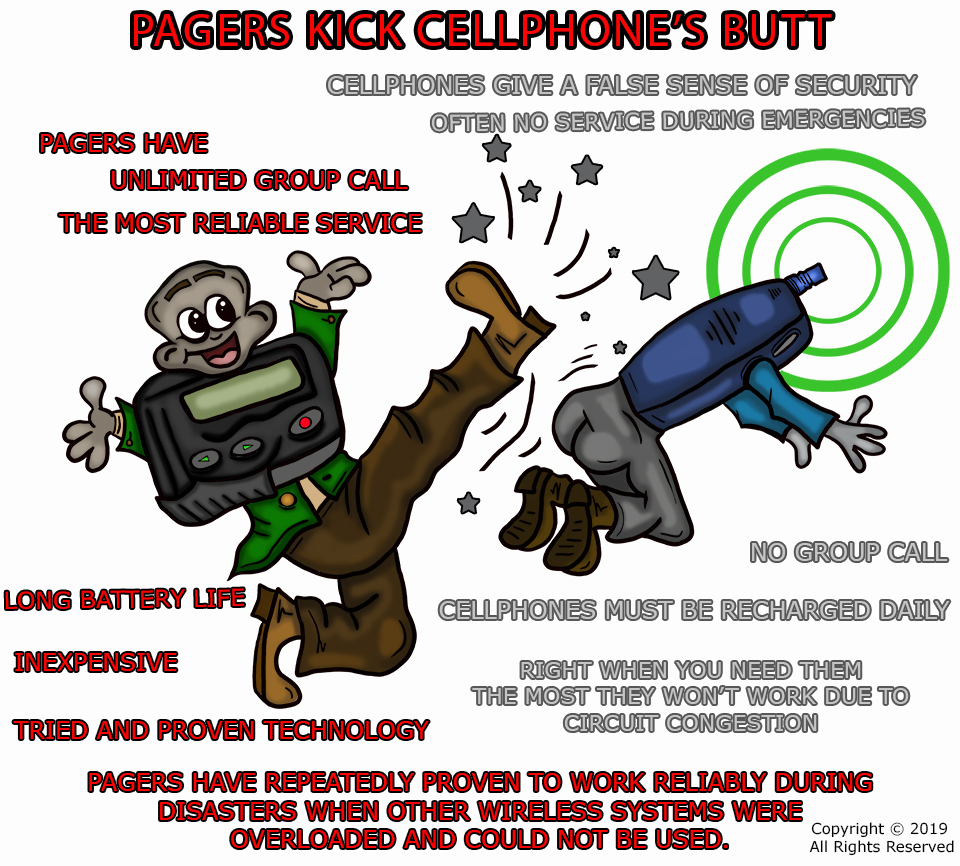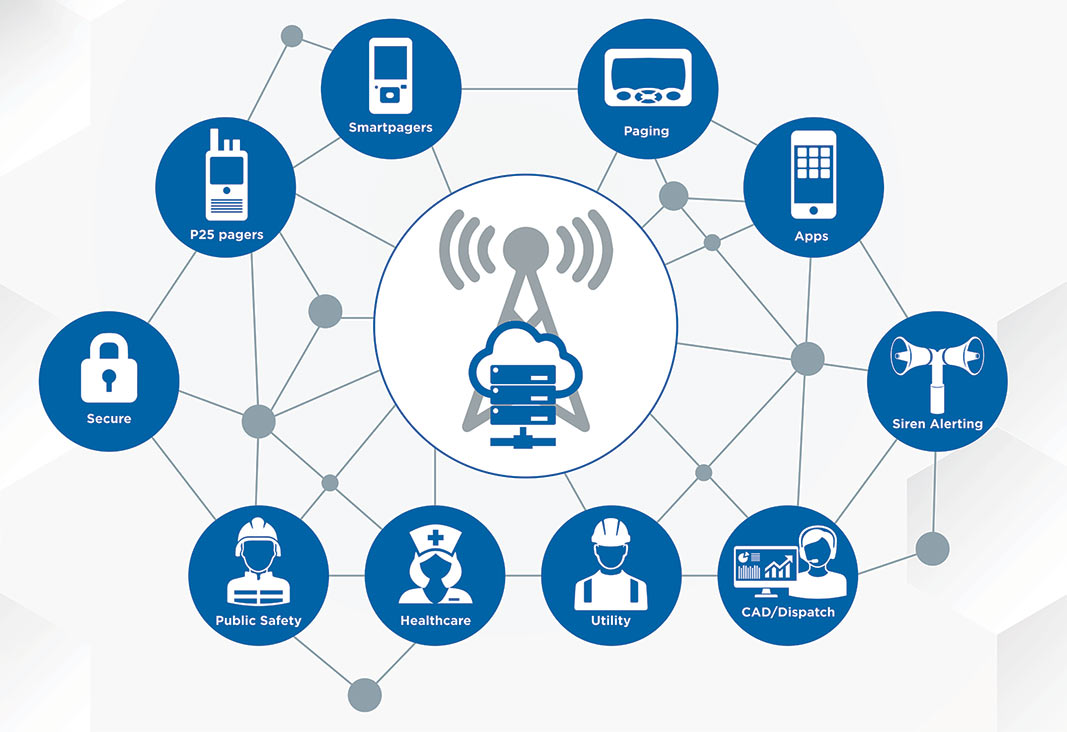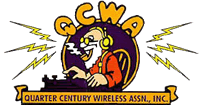

| Wireless News Aggregation |
|
Welcome Back To
The Wireless
|
NO POLITICS HERE
This doesn't mean that nothing is ever published here that mentions a US political party—it just means that the editorial policy of this newsletter is to remain neutral on all political issues. We don't take sides.
A new issue of the Wireless Messaging Newsletter is posted on the web each week. A notification goes out by e-mail to subscribers on most Fridays around noon central US time. The notification message has a link to the actual newsletter on the web. That way it doesn’t fill up your incoming e-mail account. There is no charge for subscription and there are no membership restrictions. Readers are a very select group of wireless industry professionals, and include the senior managers of many of the world’s major Paging and Wireless Messaging companies. There is an even mix of operations managers, marketing people, and engineers — so I try to include items of interest to all three groups. It’s all about staying up-to-date with business trends and technology. I regularly get readers’ comments, so this newsletter has become a community forum for the Paging, and Wireless Messaging communities. You are welcome to contribute your ideas and opinions. Unless otherwise requested, all correspondence addressed to me is subject to publication in the newsletter and on my web site. I am very careful to protect the anonymity of those who request it. I spend the whole week searching the INTERNET for news that I think may be of interest to you — so you won’t have to. This newsletter is an aggregator — a service that aggregates news from other news sources. You can help our community by sharing any interesting news that you find.
Editorial Opinion pieces present only the opinions of the author. They do not necessarily reflect the views of any of advertisers or supporters. This newsletter is independent of any trade association. I don't intend to hurt anyone's feelings, but I do freely express my own opinions.
HELP SUPPORT THE NEWSLETTER These are uncertain times.
There is not a lot of news about Paging these days but when anything significant comes out, you will probably see it here. I also cover text messaging to other devices and various articles about related technology. |
||||||||||
 |
 |
|
Subscribe Here IT'S FREE * required field
|
 |
|
Advertiser Index
|
|
Service Monitors and Frequency Standards for Sale
(Images are typical units, not actual photos of items offered for sale here.)
|
| Leavitt Communications |
|
|
|||||||||||||||||||||||||||
Ethernet: Why your home office could use more of itNearly 50 years old, this networking technology remains one of the best ways to connect home and office equipment to the Internet. We review the many options.By Jason Perlow for Tech Broiler | February 18, 2021 — 17:06 GMT (09:06 PST) It's been almost a year since many of us started working from home, and it doesn't look like that's going to change anytime soon. In previous Jason Squared shows, Jason Cipriani and I have talked about securing your home Internet. and even how to improve your Wi-Fi signal. However, there are alternative ways to improve connectivity throughout your home. Today, we will talk about one of the oldest — and perhaps still one of the best ways to connect your equipment to the Internet. — Ethernet. WHAT THE HECK IS ETHERNET, EXACTLY? Ethernet is a wired network communications standard developed in the early 1970s by a computer engineer named Bob Metcalfe (who, for many years, was also a well-known computer industry columnist at InfoWorld and also was responsible for forming 3COM, which HP later bought in 2010) and his team of researchers at Xerox's Palo Alto Research Center.
Over the years, Ethernet morphed from using coaxial cable to twisted pair cable and fiberoptic cables. The original standard called for network frames sent at 10Mbps. Today, it's not uncommon for Ethernet to communicate at 1Gbps over twisted pair cable. Ethernet can move as fast as 40Gbps/100Gbps using fiberoptic cables on enterprise networks within data centers or in specialized environments. WHY DO WE WANT TO USE ETHERNET AT HOME? Chances are, you probably already do use at least some Ethernet at home. Most consumer broadband installations will have a residential gateway that incorporates Wi-Fi and some broadband access device, like a cable modem or an optical network terminal (ONT). Those will be connected with a short Cat-5 or Cat-6 Ethernet cable and the modular RJ-45 8-pin connector. There are many homes in which that's likely the extent of their Ethernet install. But all home routers/residential gateways have at least one or more additional Ethernet ports on them, allowing you to expand that Ethernet network. So, for example, in my own home, with my AT&T ARRIS residential gateway (the main router), I have a few extra Ethernet ports. I have a 24-port Ethernet switch connected to one of these to add more Ethernet-connected devices. But you're not stuck with the number of ports on your router. An Ethernet Switch is like the USB hubs you can buy for your PC or Mac. If you run out of Ethernet ports, you buy a switch, and it will give you more network interfaces. WHY WOULD I WANT TO CONNECT MORE DEVICES TO ETHERNET RATHER THAN USE WI-FI? There are a lot of reasons. Ethernet is super-reliable for starters. It is secure; it's far more difficult for someone to sniff your network traffic if you use Ethernet, especially if you are using something like a VLAN. It's also considerably faster than the network connectivity you will get in most home environments with Wi-Fi. Even with Wi-Fi 6, you will only get 450Mbps to 650Mbps speeds under optimal conditions; you will still get interference and latency. But with my 1Gbps fiber connection from AT&T, I frequently get over 900Mbps downloads, close to wireline speeds, when using a computer connected to the Ethernet switch. The other thing that's good about Ethernet is it has pretty high distance limitations, like about 100 meters per run. So you can get the full speed out of that cable over that distance. This is good to have if you have a multi-story home, where you might have, say, an entertainment center in your basement or a bedroom on an upper floor that you want to have high-speed network connectivity. Perhaps the Wi-Fi from the bottom floor or even your mesh network just isn't cutting it because there are too many walls or whatever. You can bridge your network using a Wi-Fi access point using Ethernet, and a long cable runs to the switch or the router. You need to be able to drop that cable through a wall soffit, through the attic, or a crawlspace, or run it along the wall under the carpet to where it has to go. In my case, my office is in the room next to where all my broadband equipment is, so I hired a handyman to install an Ethernet jack on both sides of the adjoining wall. But I know many people who have just drilled through the wall, bore a hole, and put an inexpensive plastic plate there or a grommet kit that is used for pushing cables through. You can get those at Home Depot. IS IT EXPENSIVE TO BUILD OUT YOUR ETHERNET NETWORK?
It doesn't have to be expensive. I frequently see unmanaged desktop 16-port Gigabit Ethernet switches from Netgear, TP-LINK, and D-Link on Amazon for less than $60. You can buy pre-fabricated cables that are as long as 100 feet for about $22 from Best Buy or Amazon, and I have seen them as cheap as $12 at Walmart, too. But you can also crimp your own cables with a crimping tool and buy the twisted pair cable spools and the RJ-45 heads, and that's not that expensive if you have to do your own wiring. Many streaming devices have Ethernet ports already built-in, such as the Roku, the Amazon Fire TV, the Apple TV, and gaming consoles like the Xbox and the Playstation. Network adapters for laptops are also not that expensive. We talked about hubs a few weeks ago; many on the market include Ethernet and HDMI and extra USB-C and USB-A ports for like $40, such as the one from Anker. WHAT ABOUT THE PRICIER ETHERNET SWITCHES? The higher-end models are managed switches and are more expensive because they have special segmenting and security capabilities, such as for VLANs. These are typically for small and medium business use. But the other thing these more expensive switches can do is Power over Ethernet or PoE. In addition to carrying Ethernet communication, a Cat5-Cat6 twisted pair cable can also carry power. That means, if you wanted to place, say, a Wireless Access Point in some remote part of your house or in your small business where no AC power outlets exist, all you need to do is string the Cat5 cable to that location and plug in the device. This is useful for broadcasting a Wi-Fi signal to a wide-open area and mounting an access point on a ceiling. For example, in my house, I have my main AP mounted high on a wall in my living room, and that signal can reach a large part of my house. It's powered by a PoE switch connection in a spare bedroom where all my communications equipment is, including the broadband connection. To use PoE, in addition to a PoE compatible switch — and you can get them as cheaply as $80 for an 8-port version — you need to have a device that can be powered by PoE, such as a business-class access point. You can find these on Amazon for like $100 or less; Netgear has a Wi-Fi 6 one for $130. So if you're having a tough time with mesh networking routers — like I have — this is another way to get whole home or whole business Wi-Fi coverage. WHAT IF I CAN'T STRING CAT5 IN MY HOME?
There are other ways of moving Ethernet. One way of doing that is MoCA, or Multimedia over Coax, which uses the Coaxial cable you might already have in your home from back in the Cable TV or the Satellite TV days. Many homes have to coax installed many years ago, but you can also coax outdoors and back into your home if needed, as it is a thick, shielded copper cable that is designed better to be protected from the elements. A MoCA adapter is a device connected in pairs, so you have one at one side of the coax cable you want to send Ethernet signal and one at the receiving end where you might put a switch or, say, an access point or something else. Actiontec, for example, sells these in pairs for $170. It advertises up to 2.5Gbps speeds over existing coaxial cable, which is extremely fast. Trendnet sells a similar product for $110, and you can also get that on Amazon. WHAT IF YOU DON'T HAVE COAX OR DON'T WANT TO RUN NEW COAX?
Finally, we get to something called Ethernet over Powerline, or HomePlug AV2, which is like the opposite of PoE; we are sending Ethernet signal over the AC power wires that are already inside your home. Again, this uses a pair of devices. One is plugged into the wall, and then Ethernet is cabled to your switch. Another one is plugged into the wall where you want the Ethernet signal transmitted to, and then there's an Ethernet cable coming out of that, which plugs into whatever you want to plug it into. Using this method, it's possible to have these adapters plugged into outlets all over your home, so your electrical system becomes one big network. Now there are some gotchas to this: If your wiring is ancient and janky, this might not work. You also might not get good throughput out of this, either. However, it is theoretically possible to get up to a gigabit connection doing things this way. You can get the Homeplug AV2 adapters in pairs for about $70$80 on Amazon, and companies like Netgear, Trendnet, TP-Link, and D-Link make them. In my home, in the past, I've seen as high as 400Mbps per second when extending my living room's entertainment center with this type of equipment — which is about par for the course with the fastest most people are going to see with 802.11ac Wi-Fi in optimal scenarios. |
| Source: | ZDNet |
|
Paging Transmitters 150/900 MHz The RFI High Performance Paging Transmitter is designed for use in campus, city, state and country-wide paging systems. Designed for use where reliable simulcast systems where RF signal overlap coverage is critical.
Built-in custom interface for Prism-IPX ipBSC Base Controller for remote control, management and alarm reporting.
Prism-IPX Systems LLC.
11175 Cicero Dr., Alpharetta, GA 30022
|
The Wireless Messaging News
The Board of Advisor members are people with whom I have developed a special rapport, and have met personally. They are not obligated to support the newsletter in any way, except with advice, and maybe an occasional letter to the editor.
Can You Help The Newsletter?
You can help support The Wireless Messaging News by clicking on the PayPal Donate button above. It is not necessary to be a member of PayPal to use this service.
Newspapers generally cost A donation of $50.00 would certainly help cover a one-year period. If you are wiling and able, please click on the PayPal Donate button above.
|
|||||||||||||||
British Columbia Radio Amateur Copies Signal from Mars-Orbiting Satellite02/17/2021
As reported on Spaceweather.com, Canadian radio amateur Scott Tilley, VE7TIL, has snagged another signal from deep space. His latest conquest has been to copy the signal from China’s Tianwen-1 (pronounced “tee-EN-ven”) probe, which went into orbit around Mars on February 10. Tilley told Spaceweather.com that the probe’s X-band signal was “loud and audible.” “It was a treasure hunt,” Tilley told Spaceweather.com. He explained that while the spacecraft did post its frequency with the International Telecommunication Union (ITU), it was too vague for precise tuning (X band is between 8 GHz and 12 GHz). Launched last July, Tianwen-1 represents China’s first Mars mission. It consists of an orbiter and a rover, which will land on the Martian surface in May or June 2021. It is able to photograph the planet’s surface while in orbit. Finding signals from deep space is a sub-hobby for Tilley, who seeks what he calls “zombie satellites” among other signal sources. In 2020, he tracked and identified signals from the experimental UHF military communication satellite LES-5. Tilley said he found the satellite in what he called a geostationary “graveyard” orbit after noting a modulated carrier on 236.7487 MHz. Launched in 1967, LES-5 was supposed to shut down in 1972, but it continues to operate as long as its solar panels are facing the sun, Tilley explained. In 2018, while hunting for an undisclosed US government spacecraft lost in a launch mishap, he spotted the signature of IMAGE (Imager for Magnetopause-to-Aurora Global Exploration), a NASA spacecraft believed to have died in December 2005. The discovery delighted space scientists. Tilley has also picked up signals from NASA's Mars Reconnaissance Orbiter, and the United Arab Emirates Hope probe, both orbiting Mars some 124 million miles away. He uses a homemade 60-centimeter dish and relies on software-defined radios (SDRs) to accomplish the task. Radio amateurs have been listening for signals from space since the 1957 launch of Sputnik 1, which transmitted at around 20 MHz. |
| Source: | ARRL |
| PRISM IPX Systems |

| Easy Solutions |
|
Providing Expert Support and Service Contracts for all Glenayre Paging Systems. The GL3000 is the most prolific paging system in the world and Easy Solutions gladly welcomes you to join us in providing reliable support to the paging industry for many more decades in the future. Easy Solutions provides cost effective computer and wireless solutions at affordable prices. We can help in most any situation with your communications systems. We have many years of experience and a vast network of resources to support the industry, your system and an ever changing completive landscape.
Please see our web site for exciting solutions designed specifically for the Wireless Industry. We also maintain a diagnostic lab and provide important repair and replacement parts services for Motorola and Glenayre equipment. Call or
Easy Solutions |
GLENAYRE INFRASTRUCTUREI would like to recommend Easy Solutions for Support of all Glenayre Paging Equipment. This Texas company is owned and operated by Vaughan Bowden. I have known Vaughan for over 35 years. Without going into a long list of his experience and qualifications, let me just say that he was the V.P. of Engineering at PageNet which was—at that time—the largest paging company in the world. So Vaughan knows Paging. GTES is no longer offering support contracts. GTES was the original group from Vancouver that was setup to offer support to customers that wanted to continue with the legacy Glenayre support. Many U.S. customers chose not to use this service because of the price and the original requirement to upgrade to version 8.0 software (which required expensive hardware upgrades, etc.). Most contracts ended as of February 2018. If you are at all concerned about future support of Glenayre products, especially the “king of the hill” the GL3000 paging control terminal, I encourage you to talk to Vaughan about a service contract and please tell him about my recommendation. Click on the image above for more info about advertising here. |
INTERNET Protocol Terminal
The IPT accepts INTERNET or serial messaging using various protocols and can easily convert them to different protocols, or send them out as paging messages. An ideal platform for hospitals, on-site paging applications, or converting legacy systems to modern protocols.
Additional/Optional Features
Prism-IPX Systems LLC.
11175 Cicero Dr., Alpharetta, GA 30022 |
||||||||||||||||||||||||||||||
|
Paging Data Receiver PDR-4 The PDR-4 is a multi-function paging data receiver that decodes paging messages and outputs them via the serial port, USB or Ethernet connectors. Designed for use with Prism-IPX ECHO software Message Logging Software to receive messages and log the information for proof of transmission over the air, and if the data was error free.
Prism-IPX Systems LLC.
11175 Cicero Dr., Alpharetta, GA 30022 |
Wireless Network Planners
|
|||||||||||
|
Before the
REPLY TO OPPOSITION OF THE BLOOSTON RURAL CARRIERS
CONCLUSION
1 See Rural Wireless Association, Inc. and NTCA – The Rural Broadband Association Joint Petition for Reconsideration, GN Docket No. 20-32 (filed Dec. 28, 2020) (“NTCA/RWA Petition”); Petition for Reconsideration of Coalition of Rural Wireless Carriers, GN Docket No. 20-32 (filed Dec. 28, 2020) (“Rural Coalition Petition”), Petition for Partial Reconsideration of CTIA, GN Docket No. 20-32 (filed Dec. 28, 2020) (“CTIA Petition”). 2 See, e.g., Joint Applicants’ Petition for Modification of Decision 20-04-008, In re Joint Application of Sprint Communications Company, L.P. and T-Mobile USA, Inc, California PUC Application 18-07-011 (filed, June 23, 2020), at 3 Rural Coalition Petition at pp. 10-11. 4 Comments of Competitive Carriers Association, GN Docket No. 20-32 (filed February 8, 2021) (“CCA Comments”) at p. 2. 5 CTIA Petition at p. 6. |
| Source: | Blooston, Mordkofsky, Dickens, Duffy & Prendergast, LLP |
Brad Dye, Ron Mercer, Allan Angus, Vic Jackson, and Ira Wiesenfeld are friends and colleagues who work both together and independently, on wireline and wireless communications projects.
Click here Note: We do not like Patent Trolls, i.e. “a person or company who enforces patent rights against accused infringers in an attempt to collect licensing fees, but does not manufacture products or supply services based upon the patents in question.” We have helped some prominent law firms defend their clients against this annoyance, and would be happy to do some more of this same kind of work. Some people use the title “consultant” when they don't have a real job. We actually do consulting work, and help others based on our many years of experience. “If you would know the road ahead, ask someone who has traveled it.” — Chinese Proverb WHAT IS 5G? 5G is the ext generation of wireless networks and promises a mobile experience that's 10x to 100x faster than today's 4G networks. We say the word promise because we're in the early days of 5G. When more smartphones and networks support 5G tech, it will have far-reaching consequences for consumers, from the cars we drive (or that drive us) to the food we eat to the safety of our roads to the ways we shop to the entertainment we share with family and friends. And that doesn't include things we haven't yet imagined because we've never had the capability to unlock those new scenarios. Today, 5G may seem confusing even as it's widely hyped. We're here to help you sort fact from fiction, weed through the acronyms and jargon, and figure out when and how 5G can change the way you live. And we'll keep you from getting caught up in hyperbole — and empty promises. [ source ] |
Remote AB Switches ABX-1 switches are often used at remote transmitter sites to convert from old, outdated and unsupported controllers to the new modern Prism-IPX ipBSC base station controllers. Remotely switch to new controllers with GUI commands. ABX-1
ABX-3 switches are widely used for enabling or disabling remote equipment and switching I/O connections between redundant messaging systems. ABX-3
Common Features:
Prism-IPX Systems LLC.
11175 Cicero Dr., Alpharetta, GA 30022 |
| Leavitt Communications |
|
|||||||
| Inside Towers Newsletter |
Trade Associations Send Letter to White House: “Build Broadband for All”
February 19, 2021 5:57 am The heads of three broadband trade associations sent a letter to the White House Thursday urging stronger action on universal broadband access. Signing the letter were Chip Pickering from INCOMPAS, who represents competitive fiber and fixed wireless builders, Shirley Bloomfield of NTCA–The Rural Broadband Association representing rural providers, and Jonathan Adelstein from WIA, which counts wireless infrastructure companies as members. In the letter, they called on the Biden Administration to make “Broadband for All” central to its COVID-19 recovery efforts as infrastructure investment will stimulate education, telemedicine and small business growth. The letter states, “Despite best efforts, we still face serious challenges in connecting all Americans, including businesses of all sizes, to high-speed broadband. We realize that the mission to achieve universal broadband availability is an ambitious but essential goal. In order to address the growing digital divide in this country and to expand the availability of faster, more affordable broadband in our communities, we call on your administration, Congress, and the [FCC] to support additional funding for a better broadband future for all Americans.” The associations call for action that targets underserved areas that need it most, helping low-income Americans stuck on the wrong side of the digital divide purchase broadband services at affordable prices. The letter calls for federal investment in wired, wireless and 5G infrastructure and better state and local coordination to remove barriers to deployment, ensuring that funding from the FCC’s Emergency Broadband Benefit Program and future investments reach families and communities in need faster, stating, “COVID-19 has exposed deep gaps in Americans’ ability to access the internet, and it is time for our nation’s leaders and for Congress to act. Unfortunately, we hear too often about kids doing homework in parking lots because they lack access to fast, affordable broadband at home. This is a national tragedy. To meet this challenge, we ask the federal government to enable solutions that will make a significant difference in the lives of many.” |
| Source: | Inside Towers newsletter | Courtesy of the editor of Inside Towers Jim Fryer. Inside Towers is a daily newsletter by subscription. |
| BloostonLaw Newsletter |
REMINDER: First Performance Measurement Pre-Testing Due March 31Carriers that accepted support under the ACAM, Revised ACAM, the Alaska Plan, or the Rural Broadband Experiment programs are required to comply with performance measurement pre-testing obligations and report on the results by the last week of each quarter in 2021. The first such report is due by March 31, 2021. Specifically, carriers must conduct performance measures testing at a random sample of locations selected by USAC and submit the results to USAC within one week of the end of the quarter, but will not face withholding of support for failing to meet speed and latency standards. USAC encourages carriers to file results as soon as pre-testing is complete each quarter. BloostonLaw Contacts: John Prendergast and Sal Taillefer HeadlinesHouse Republicans Announce Broadband Bill PackageOn February 16, House Energy and Commerce Republican Leader Cathy McMorris Rodgers (R-WA) and Republican Subcommittee Leader for Communications and Technology Bob Latta (R-OH) announced a comprehensive package of 28 bills that “aim to turbocharge public and private investment by promoting new and upgraded infrastructure deployments, boosting competition, streamlining permitting processes, facilitating broadband deployment on federal lands, and closing the digital divide in both rural and urban areas.” The 28 bills in the package cover a number of areas concerning broadband deployment, including items that:
A more comprehensive summary of each of the 28 bills can be found here. Reps. McMorris Rodgers and Latta issued the following statement on the bills: “The COVID-19 pandemic has amplified the challenges faced by families and workers who still do not have reliable access to the Internet. This has prevented millions from accessing vital health care, remote work, and economic resources. Unreliable Internet. and limited broadband access has also set countless children back in school because of connectivity issues while far too many schools remain closed. It’s unacceptable and hurting the next generation. To make a strong comeback from this pandemic, every House Republican on Energy and Commerce is leading in the Boosting Broadband Connectivity Agenda so America closes the digital divide. This agenda will get education back on track and promote economic opportunity for all Americans across the entire country.” Commissioner Carr said, “The Republican Members of the House Energy and Commerce Committee have introduced a smart set of infrastructure reforms that would advance a bold and effective connectivity agenda. Their thoughtful reforms would help close the digital divide and further extend America’s leadership in 5G by helping to accelerate the build out of high-speed connections and boost competition for Americans’ broadband dollars. Their ideas, including legislation that would tackle the permitting delays that persist for Internet. builds on federal lands, would make an immediate difference for rural communities across the country. I applaud their leadership and would encourage everyone that wants better, faster, and cheaper Internet. services to work towards passing this important set of reforms.” Commissioner Simington said, ““This legislation would create the environment necessary to speedily expand access to broadband for the Americans who need it most. I applaud Congresswoman McMorris Rodgers and her colleagues for their leadership.” BloostonLaw Contacts: Ben Dickens, Gerry Duffy, and John Prendergast. FCC to Re-Charter NANC, Solicits NominationsOn February 16, the FCC issued a Public Notice announcing that it plans to re-charter the North American Numbering Council (NANC or Council), subject to approval of the General Services Administration’s Federal Advisory Committee Secretariat. Interested parties must submit nominations for NANC membership to the FCC no later than March 18, 2021. According to the Public Notice, the Council’s mission will be to recommend to the FCC ways to modernize administration of the NANP in order to ensure the efficient, impartial assignment and use of vital numbering resources in the evolving world of communications. The Public Notice further states that the FCC seeks applications from every sector of the telecommunications industry, as well as members representing regulators, standards bodies, and consumer — particularly individuals with expertise and interest in numbering policies, including expertise in network operations and network engineering, representing the following: Wireline and wireless telecommunications service providers of all sizes, including small and mid-size providers; Interconnected Voice over Internet. Protocol and other IP-enabled service providers; Cable service providers; Independent network builders and networking equipment installers; Other entities involved in deploying broadband; Industry trade and standards associations; State, local, and Tribal government regulators and telecommunications officials; Consumer and community organizations; Telecommunications equipment manufacturers; and Other stakeholders and interested parties with relevant experience. According to the Public Notice, members are required to participate in deliberations of at least one subcommittee or other subgroup, if any are established. The FCC may ask the Council or subcommittees or subgroups to create written recommendations or reports to the FCC. The time commitment for participation in any subcommittee or other subgroup may be substantial. However, subcommittee or other subgroup meetings may be conducted informally, using suitable technology to facilitate the meetings, subject to oversight by the Designated Federal Officer of the NANC. BloostonLaw Contacts: John Prendergast, Cary Mitchell, and Sal Taillefer. Law and RegulationComments on STIR/SHAKEN Certificate Revocation Appeal ProcessOn February 17, the FCC published in the Federal Register its Notice of Proposed Rulemaking proposing a framework for voice service providers to appeal decisions by the STIR/SHAKEN Governance Authority to revoke Service Provider Code (SPC) tokens. Comments are due March 19, and reply comments are due April 19. As we reported in a previous edition of the BloostonLaw Telecom Update, the FCC is proposing an oversight role in which it would review the Governance Authority’s token revocation decisions, similar to the role it currently holds in the context of decisions by the Universal Service Administrative Company (USAC). Indeed, the proposes rules would follow the same format as the rules for appealing a decision of USAC. Under the universal service appeals rules, after first seeking internal review by USAC, an aggrieved party may seek review of USAC’s decision by the FCC. The proposed procedure for STIR/SHAKEN Governance Authority decisions would use similar procedural and timing requirements. SPC tokens are issued by the STIR/SHAKEN Policy Administrator, and can be revoked by the Governance Authority. The SPC token permits a voice service provider to obtain the digital certificates it will use to authenticate calls from one of the approved Certification Authorities. The SPC token therefore is a prerequisite for a voice service provider to participate in the STIR/SHAKEN ecosystem, and management of token access is the mechanism by which the Policy Administrator and Governance Authority protect the system from abuse and misuse. Reasons for revoking an SPC can include: 1) compromised credentials, i.e., a voice service provider’s private key has been lost, stolen, or compromised, or a certification authority has been compromised; (2) the voice service provider exits the STIR/SHAKEN ecosystem; (3) the voice service provider fails to adhere to the policy and technical requirements of the system, including the SPC Token Access Policy, funding requirements, or technical specifications regarding the use of STIR/SHAKEN; or (4) when directed by a court, the FCC, or another body with relevant legal authority due to a violation of Federal law related to caller ID authentication. BloostonLaw Contacts: Ben Dickens, Gerry Duffy, Mary Sisak, and Sal Taillefer. Comments on NECA Average Schedule Formula Modifications Due March 15On February 12, the FCC issued a Public Notice seeking comment from interested parties on the proposed modification of average schedule formulas that the National Exchange Carrier Association, Inc. (NECA) filed on December 23, 2020. As required by the FCC’s rules, NECA proposes to revise the formulas for average schedule interstate settlement disbursements in connection with the provision of interstate access services for the period of July 1, 2021, through June 30, 2022. Comments are due March 15, and reply comments are due March 30. Exchange Carriers (ECs) that participate in NECA’s access charge pools receive compensation for providing interstate access services either on the basis of their actual costs or a set of interstate average schedule formulas. Recognizing that it is inefficient to require cost separation studies for all companies as not all ECs have the resources available to perform these studies, the FCC’s rules permit certain ECs to receive interstate access settlements based upon a set of “average schedule” formulas developed by NECA. The FCC’s rules require NECA either to file revised formulas on or before December 31st of each year, or to certify that no such revisions are necessary. This year’s modification filing can be found here. BloostonLaw Contacts: Ben Dickens and Sal Taillefer. IndustryNext Meeting of Precision Agriculture Task Force Scheduled for March 12On February 16, the FCC issued a Public Notice announcing that the next meeting of the Task Force for Reviewing the Connectivity and Technology Needs of Precision Agriculture in the United States (Precision Ag Connectivity Task Force or Task Force) will be held Friday, March 12, 2021, beginning at 12:00 p.m. (noon) EST. At this meeting, the Task Force will consider and vote on a report from its Accelerating Broadband Deployment on Unserved Agricultural Lands Working Group. The Task Force will also discuss any updates and matters from its other working groups. The meeting will be wholly electronic and is open to the public on the Internet. via live feed from the FCC’s web page at www.fcc.gov/live. The Precision Ag Connectivity Task Force provides advice and recommendations for the FCC on how to assess and advance deployment of broadband Internet. access service on unserved agriculture land to promote precision agriculture. Congress directed the FCC, in consultation with the Secretary of the Department of Agriculture, to establish the Precision Ag Connectivity Task Force in the Agricultural Improvement Act of 2018 (2018 Farm Bill). DeadlinesMARCH 1: COPYRIGHT STATEMENT OF ACCOUNT FORM FOR CABLE COMPANIES. This form, plus royalty payment for the second half of last year, is due March 1. The form covers the period July 1 to December 31, and is due to be mailed directly to cable TV operators by the Library of Congress’ Copyright Office. If you do not receive the form, please contact Gerry Duffy. MARCH 1: CPNI ANNUAL CERTIFICATION. Carriers should modify (as necessary) and complete their “Annual Certification of CPNI Compliance” for this year. The certification must be filed with the FCC by March 1. Note that the annual certification should include the following three required Exhibits: (a) a detailed Statement Explaining How The Company’s Operating Procedures Ensure Compliance With The FCC’S CPNI Rules to reflect the Company’s policies and information; (b) a Statement of Actions Taken Against Data Brokers; and (c) a Summary of Customer Complaints Regarding Unauthorized Release of CPNI. A company officer with personal knowledge that the company has established operating procedures adequate to ensure compliance with the rules must execute the Certification, place a copy of the Certification and accompanying Exhibits in the Company’s CPNI Compliance Records, and file the certification with the FCC in the correct fashion. Our clients can forward the original to BloostonLaw in time for the firm to make the filing with the FCC by March 1, if desired. BloostonLaw is prepared to help our clients meet this requirement, which we expect will be strictly enforced, by assisting with preparation of their certification filing; reviewing the filing to make sure that the required showings are made; filing the certification with the FCC, and obtaining a proof-of-filing copy for your records. Clients interested in obtaining BloostonLaw's CPNI compliance manual should contact Gerry Duffy (202-828-5528). Note: If you file the CPNI certification, you must also file the FCC Form 499-A Telecom Reporting Worksheet by April 1. BloostonLaw contact: Gerry Duffy. MARCH 1: FCC FORM 477, LOCAL COMPETITION & BROADBAND REPORTING FORM. This annual form is due March 1 and September 1 annually. The FCC requires facilities-based wired, terrestrial fixed wireless, and satellite broadband service providers to report on FCC Form 477 the number of broadband subscribers they have in each census tract they serve. The Census Bureau changed the boundaries of some census tracts as part of the 2010 Census. Specifically, three types of entities must file this form:
BloostonLaw contacts: Ben Dickens, Gerry Duffy, and Mary Sisak. APRIL 1: FCC FORM 499-A, TELECOMMUNICATIONS REPORTING WORKSHEET. This form must be filed by all contributors to the Universal Service Fund (USF) sup-port mechanisms, the Telecommunications Relay Service (TRS) Fund, the cost recovery mechanism for the North American Numbering Plan Administration (NANPA), and the shared costs of local number portability (LNP). Contributors include every telecommunications carrier that provides interstate, intrastate, and international telecommunications, and certain other entities that provide interstate telecommunications for a fee. Even common carriers that qualify for the de minimis exemption must file Form 499-A. Entities whose universal service contributions will be less than $10,000 qualify for the de minimis exemption. De minimis entities do not have to file the quarterly report (FCC Form 499-Q), which was due February 1, and will again be due May 1. Form 499-Q relates to universal and LNP mechanisms. Form 499-A relates to all of these mechanisms and, hence, applies to all providers of interstate, intrastate, and international telecommunications services. Form 499-A contains revenue information for January 1 through December 31 of the prior calendar year. And Form 499-Q contains revenue information from the prior quarter plus projections for the next quarter. (Note: the revised 499-A and 499-Q forms are now available.) Block 2-B of the Form 499-A requires each carrier to designate an agent in the District of Columbia upon whom all notices, process, orders, and decisions by the FCC may be served on behalf of that carrier in proceedings before the FCC. Carriers receiving this newsletter may specify our law firm as their D.C. agent for service of process using the information in our masthead. There is no charge for this service. BloostonLaw Contacts: Ben Dickens, Gerry Duffy, and Sal Taillefer. APRIL 1: ANNUAL ACCESS TO ADVANCED SERVICES CERTIFICATION. All providers of telecommunications services and telecommunications carriers subject to Section 255 of the Telecommunications Act are required to file with the FCC an annual certification that (1) states the company has procedures in place to meet the record-keeping requirements of Part 14 of the Rules; (2) states that the company has in fact kept records for the previous calendar year; (3) contains contact information for the individual or individuals handling customer complaints under Part 14; (4) contains contact information for the company’s designated agent; and (5) is supported by an affidavit or declaration under penalty of perjury signed by an officer of the company. BloostonLaw Contacts: Gerry Duffy, Mary Sisak, Sal Taillefer. Calendar At-a-GlanceFebruary March April
|
|
||||||
| THIS WEEK'S MUSIC VIDEO |
“The Creeper”Tuba Skinny
|
|
Source: |
 Best regards,  Newsletter Editor 73 DE K9IQY Licensed since 1957 |
Current member or former member of these organizations. | ||||
| The National Rifle Association |
MENSA MEMBER |
A Public Library of  Paging and Wireless Messaging Information |
Wireless  Messaging |
||
|
Critical Messaging  Association |
European Mobile Messaging Association Former Board Member |
ZP5TQ  Radio Club of Paraguay |
Quarter Century  Wireless Association |
|
Back To Paging  Still The Most Reliable Wireless Protocol For Emergencies! |
American Association of Woodturners |
U.S. Navy  Radioman |
U.S. Navy Radioman  Second Class Petty Officer |
Boy Scouts of America  National Honor Society |
Creator of the  Paging Wheel of Fortune |
National Skeet  Shooting Association |
Institute Electrical and  Electronics Engineers |
American Radio  Relay League |
The Radio Club  of America |
Life is good! |
|
|
CONTACT INFO & LINKS
|
Amateur Radio
|
VETERAN  United States Navy |
|||
| Home Page | Directory | Consulting | Newsletters | Free Subscription | Products | Reference | Glossary | Send e-mail |